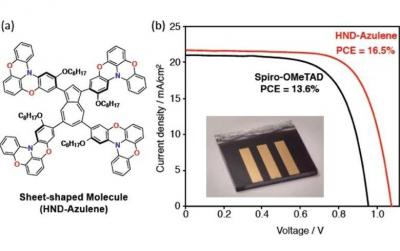Researchers at the Japanese Kyoto University have designed a material called HND-Azulene, that can, when used as a hole-transporting material (HTM), increase the efficiency of perovskite solar cells by up to 20% when compared to the commonly used Spiro-OMeTAD. Such perovskite PV cells have exhibited a power conversion efficiency of over 16.5%, compared to an efficiency of 13.6% for cells using the current standard Spiro-OMeTAD.

The research team has designed and synthesized the HND-Azulene system with a sheet-shaped structure. Based on the evaluation and a comparison of the optoelectronic and electrochemical properties of HND-Azulene and Spiro-OMeTAD, the researchers were been able to determine the factors that are required for HTMs to act efficiently in perovskite solar cells. In line with these new molecular design principles, they believe that more sophisticated HTMs should be easily attainable.

